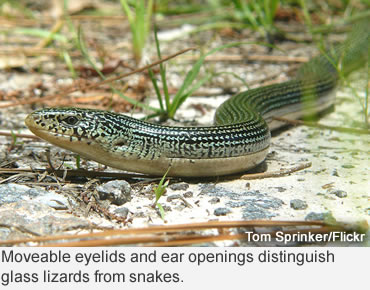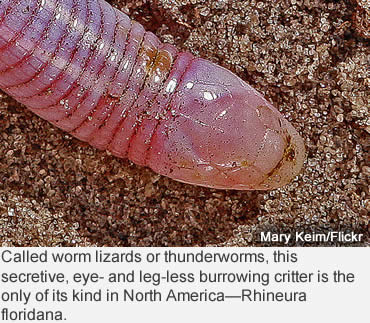Photo: This charming glass lizard has a unique way to escape enemies by shedding its tail.
You’re on a hike in the woods when you glance down and stop moving. That’s a snake, right? However, a second look may have you wondering if it’s a snake or a lizard.
Glass lizards are easily misidentified as snakes, and chances of finding one during May increase as temperatures warm and their breeding season begins.
Glass lizards—both the Eastern and Western variety—are legless. If you take a close look at this timid creature, you’ll spot the differences between lizards and snakes.
Unlike snakes, these legless reptiles have moveable eyelids and ear openings. Their name reflects the fragile nature of their bony tails. When they’re disturbed or alarmed, they easily shed their tails as a defense mechanism against an attack.
 Tails, which are usually more than half a glass lizard’s total length, break away and the broken portions flip violently, distracting a potential predator while the rest of the lizard silently escapes.
Tails, which are usually more than half a glass lizard’s total length, break away and the broken portions flip violently, distracting a potential predator while the rest of the lizard silently escapes.
Although the tail breaks in half or in several pieces along the tail vertebra, the muscles, nerves and blood vessels separate so the lizard suffers almost no blood loss.
Their tails slowly regenerate, and the new tail pattern coloration looks a bit different and sometimes darker, than the original.
In June and July females lay 5 to 16 eggs and then wait for youngsters to hatch in August and September. The hatchlings are usually 4 inches long, and at maturity, slender glass lizards are usually 33 inches in length or longer.
The lizards never worry about not finding something to eat since their dining preferences are arthropods—a vast variety of insects, crustaceans, spiders, scorpions and centipedes.
Slender glass lizards enjoy a long life, typically reaching 9 years of age. Look for Western slender glass lizards in open grasslands and along roads in wooded areas of their range from Southern Wisconsin to Texas and into Kansas.
Eastern slender glass lizards live near wetlands, but commonly live in pine flatwoods, sand dunes and other sandy habitats in the Southeastern states of Mississippi, Alabama, Georgia, South and North Carolina and all of Florida.
In Florida the Eastern glass lizard shares habitat with another frequently misidentified legless lizard—the North American worm lizard.
 Despite its name, it is neither a lizard nor a worm. Commonly called worm lizards or thunderworms for their habit of surfacing after a heavy rain or when soil has been turned, they are actually the only member the species Rhineura floridana.
Despite its name, it is neither a lizard nor a worm. Commonly called worm lizards or thunderworms for their habit of surfacing after a heavy rain or when soil has been turned, they are actually the only member the species Rhineura floridana.
They share the same reptilian family as snakes and lizards, but this amphisbaenid, which ranges from 6 to 12 inches long, is the only such native to North America.
Earthworms, which they most resemble, are on their menus, as are insects and any small invertebrate. Their heads have no eyes and they use a shovel-like snout to burrow. Their bodies have loose, ring type scales, and they lay small white oblong eggs which hatch in 2 to 3 months.
These secretive legless burrowers can only be found in Florida, and not farther north than the panhandle. They prefer living underground and enter their burrows tail first.
Resources: Oklahoma Department of Wildlife Conservation, Missouri Department of Conservation, Florida Museum of Natural History.